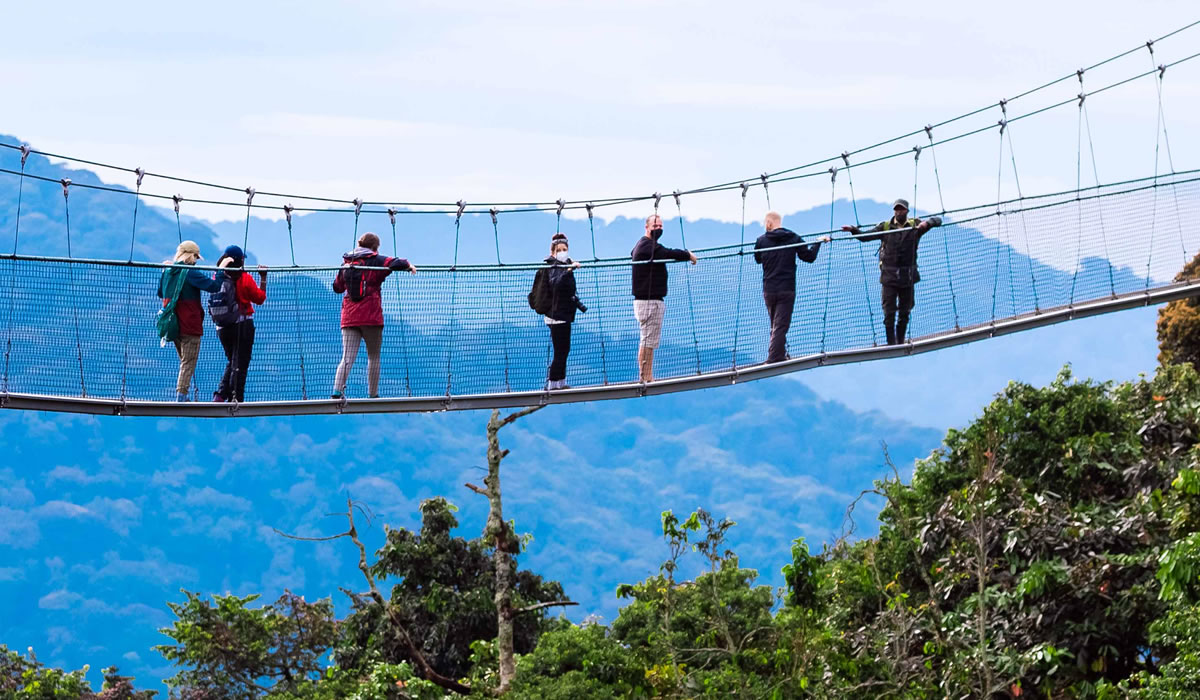Thanks to its diverse primate species, 1,068 plant species and 140 varieties of orchids, this forest park is beyond words!!! It lies on a highland that is surrounded by some of Rwanda’s most enchanting tea plantations.
To be able to experience all the adventures that Nyungwe offers, one needs at least a week. However if time isn’t in your side, you can narrow it down to three days of bird watching, chimp trekking and, a daring pursuit of a suspended canopy walkway. Another praiseworthy feature of this park is a high standard of guiding, and an admirable network of trails.
Among the 13 species of apes to which Nyungwe Forest National Park is home, the principle attraction remains the chimpanzees. You will be amazed by this subtle primate species during the quality time you will have with them during your chimp trekking experience.

Watching at them live is like staring at a wild version of you in the mirror. They look and act so much like man except for the fact that they don’t speak but rather communicate through loud vocalizations.
One of the most gripping encounters is seeing them drum buttress roots with more bravado than pleasure. Prepare to be awe-struck! Although there will be other guests on the walk, you will have an ample opportunity to get good pictures.
However, don’t spend the entire time on lens. Put your camera down for some time and take in every sense of the experience. It will leave you with sweet memories of full immersion in the moment.
Prior to the end of your nature walk in the Nyungwe, you are likely to run into several families of both old world and new world monkeys as they roam around the park. It could be a troop of baboons, a pack of black and white monkeys or vervets.
Alternatively, it could be the red colubus or the L’Hoest, a monkey species endemic to the Albertine Rift. Having been habituated, all of the mentioned species interact freely with humans. As such, there is a great chance some of their members they might draw so close to you, especially the babies.
Nyungwe as a Family Destination
One of the things that make Nyungwe a great family destination is that it equally features trails like Igishigishigi, a 2.1km course that even minors can pursue. Due to its gently rising gradient, this comfortable trek amazes nature lovers with its majestic views of the canopy walkway and stunning wildflowers. To discover more of natures’ best kept secrets in Nyungwe, you can combine the Igishigishigi with the longer Imbaraga or Umoyove Trails.
Another perfect alternative is the Mahogany Trail. It offers a good opportunity to relax by a waterfall, take a stroll under some of the tallest trees in tropical Africa. For much of your hike, you will indulge in the scent of aromatic leaves.
Bird watching in Nyungwe National Park
For the avid birdwatcher, a visit to Nyungwe is a must. Here, you stand pleasant chances of encountering 322 birds species including 29 other Albertine Rift Endemic species. This includes Rockeffer’s sunbird, Albertine owlet and Red-collared babbler. The only other habitations where you can find them are inaccessible parts of the DR Congo.
Another obvious highlight is the garish great blue turaco, which is popular for gliding in the canopy like a psychedelic turkey.
Among the 15 trails in the park, theKaramba trail is most preferred for bird watching as it is easy on the muscles. Situated en-route a former gold mine, local market and army camp, Karamba is flanked by numerous fern trees.
This meandering trail is unforgettable for its sight of iridescent colours of sunbirds that hover above tropical flowers. Butterflies are also a common sight here, with at least 120 species. At the climax of your adventure, you can cool off in the spray of a jungle waterfall, it is a sensational treat for the senses.
Best time for Rwanda bird watching in Nyungwe Forest
Considering that forest birding depends on calls, January to June is the best time to go bird watching in Nyungwe. In contrast, most of the birds keep quiet during May and June as they are focused on feeding their fledglings and keeping quiet. Migratory birds are more available from November to April.

